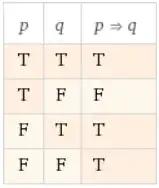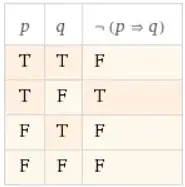The issue you seem to be having is confusing truth with validity. In particular, you are confusing $\neg(P\to Q)$ being true (and thus $P\to Q$ being false) with $P\to Q$ being invalid. (Instead of "valid", it is more likely that you've seen "is a tautology".)
When we're going through a logical argument, the atomic propositions, $P$ and $Q$ in this case, are known or assumed to hold some particular truth values. This is typically formalized by saying we have some truth assignment for all the atomic propositions. We can then calculate what the truth value for a whole formula, e.g. $P\to Q$, is given that truth assignment.
In early logic classes, you are often being asked to show that a given formula is or is not a tautology, i.e. that it is or is not valid. Doing this means showing that the formula is true for all truth assignments. As I said in the first paragraph, you seem to be confusing "$\varphi$ is false" with "$\varphi$ is invalid", probably because you've been given exercises to show that some formula is "false" that should have been stated as, "show that some formula is not a tautology".
So $\neg(P\to Q)$ being valid doesn't mean $P\to Q$ is invalid (which is what "not always true" means); it would mean that $P\to Q$ is always false. Since $P\to Q$ is not always false, neither $P\to Q$ nor $\neg(P\to Q)$ are valid. This situation is sometimes described as $P\to Q$ being contingent. On the other hand, if $\neg(P\to Q)$ is true with respect to some truth assigment, then $P\to Q$ is false with respect to the same truth assignment by definition of $\neg$. Two (propositional) formulas are (semantically) equivalent if they have the same truth value for each truth assignment. Again, by definition of $\neg$, this will never happen with a formula and its negation.

